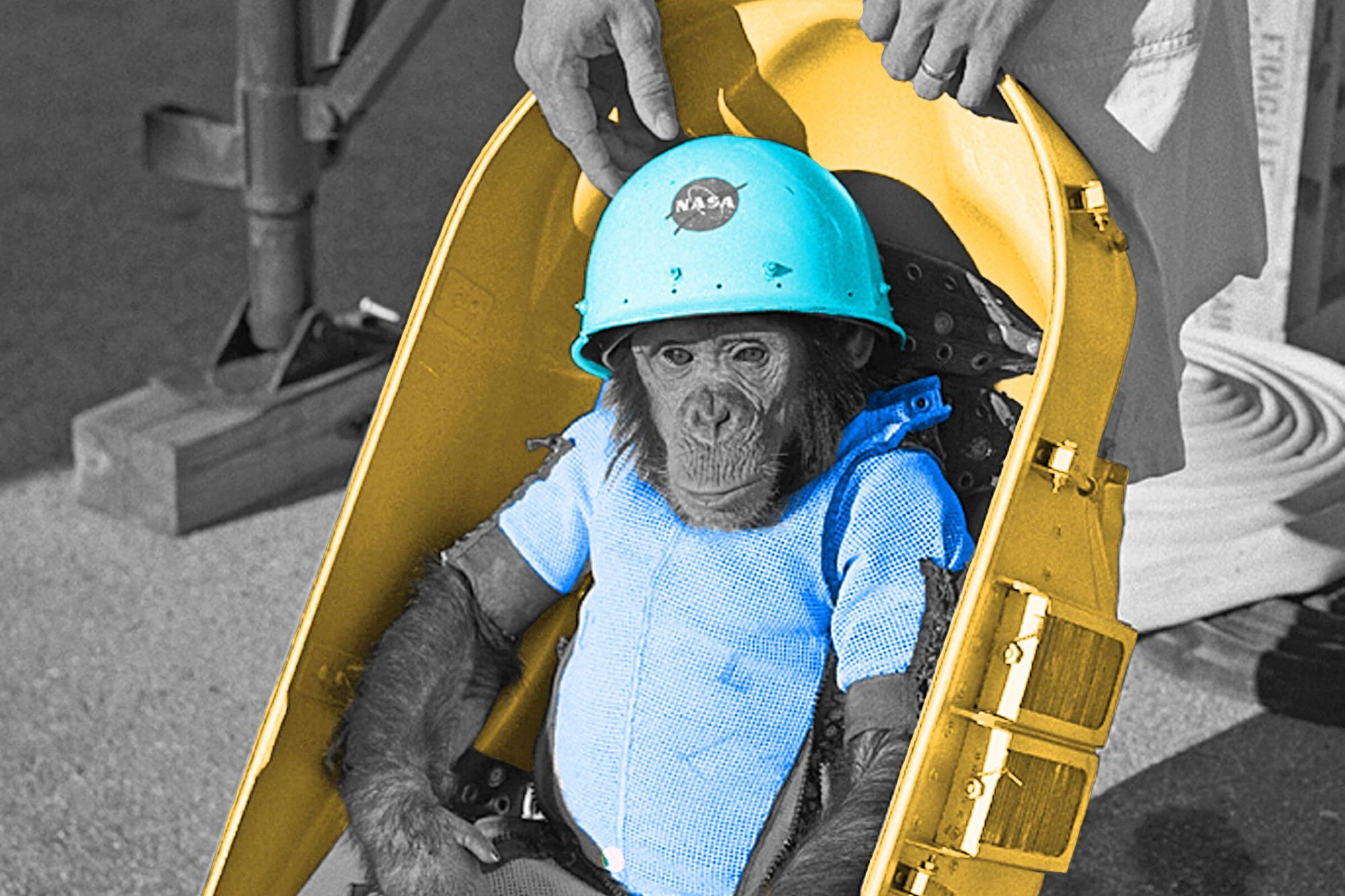

In 1783, the Montgolfier brothers — a pair of French aviation pioneers — set up a hot air balloon and placed inside the basket a sheep, duck, and rooster. Surrounded by a roaring crowd, these creatures would become the first passengers of a balloon flight in history. Ever since, humanity has been reaching higher and higher into the sky — and testing what they could up bring with them. Here’s a list of some of the strangest things to make it beyond Earth’s orbit.
Ham the Astrochimp

We’ve sent fruit flies, mice, dogs, squirrel monkeys, and rabbits into space. All of these creatures functioned as mere passengers — but not Ham the Chimp. He was trained to interact with the spacecraft, pulling levers in response to light cues. In 1961, he was launched into space, performed his tasks correctly (thus demonstrating that human astronauts would also be able to perform physical tasks in orbit), and survived the trip back to Earth. He lived for another 22 years, enjoying retirement at various zoos.
Pizza
In 2001, Pizza Hut delivered a few slices of extra-salty salami pizza to the International Space Station. The lucky recipient of the delivery — which reportedly cost $1 million — was Russian cosmonaut Yuri Usachov. It’s unclear if he left a tip.
A Wad of 100 $2 Bills

The crew of Apollo 15 brought two wads of cash onto the moon with the intention of selling them as souvenirs back on Earth. Unfortunately, they forgot one pack of bills. (Maybe it could be used for that tip?)
Harmonica and Bells
In December 1965, Gemini astronaut Wally Schirra reported back to Earth: "I see a command module and eight smaller modules in front. The pilot of the command module is wearing a red suit." Schirra then began playing “Jingle Bells” on a harmonica, with his co-pilot playing the bells — the first musical instruments (and prank!) launched into space.
A Bible

In 1971, astronaut James Irwin left a Bible on the dashboard of the Lunar Roving Vehicle. His time on the moon was, quite literally, a religious experience: One year later, he quit the astronaut corps and founded an evangelical organization.
Hammocks
Sleeping on the moon was extremely uncomfortable. So starting with Apollo 12, astronauts were given hammocks made of beta cloth (the same woven glass-fiber cloth used in NASA spacesuits). “They also had blankets, insulators, and Velcro attachment pads to help them settle in, not fall, and keep warm,” according to Discover magazine. Much of it was left on the moon.
Document Proclaiming “University of Michigan Club of the Moon”

Apollo 15 astronauts James Irwin, Alfred Worden, and David Scott all had a connection to the University of Michigan. To celebrate, they left a document proclaiming a “University of Michigan Club of the Moon,” an official branch of the alumni association, on the moon’s surface. As far as we know, it’s still up there.
Urine Receptacle System and Defecation Collection Devices
NASA maintains a 796-item catalogue of “Manmade Material on the Moon.” The list includes vomit bags and various means of collecting human excreta, which were left on the lunar surface. (Teasel Muir-Harmony, a curator at the National Air and Space Museum, once told Popular Science that “Buzz Aldrin often claims to be the first person to urinate on the moon.”)
Gene Roddenberry

The creator of the original Star Trek series, Roddenberry was the first person to make space his permanent resting place. In 1992, some of his ashes were launched into orbit aboard the space shuttle Columbia. More of his ashes went to space aboard a private spacecraft in 1997.
Wrist Mirrors
Apollo astronauts had a tough time leaning over. This made reading the frame counter on their cameras difficult, since it was fixed to the front of the spacesuit. The wrist mirror, however, helped the Apollo 16 and 17 astronauts read how much film they had left. (The mirrors were also useful for shining lights into dark areas.) When they lifted off, they left some of these mirrors on the moon.
A Family Photograph

The youngest man to walk on the moon, Charles Duke, left a picture of him with his wife and two children on the lunar surface. On the back is written: “This is the family of astronaut Charlie Duke from planet Earth who landed on the moon on April 20, 1972.”
Used Wet Wipes
The used wet wipes discarded on the lunar surface were rather useless when it came to their original purpose. Moon dust is surprisingly static. According to the Soil Science Society of America, “Cleaning the resulting charged particles with wet wipes only makes [the dust] cling harder to camera lenses and helmet visors.”
Golf Balls

When Alan Shepard visited the moon with Apollo 14, he used a modified sample device to wack some golf balls. Shepard joked that his second shot traveled “miles and miles.” (More like a couple yards.) While the balls are still sitting in the lunar sand traps, the “club” now rests at the USGA Museum in New Jersey.
Laser Range Retroreflector
Nearly every item left on the moon is junk, discarded to lighten a return trip’s load. One exception: The Laser Range Retroreflectors on the moon’s surface. These devices (special mirrors that reflect light in a particular way) are still used to measure the distance between Earth and the moon to an accuracy of three centimeters. The data has even helped test Einstein’s theory of relativity.
Tesla Roadster

In February 2018, SpaceX launched a Tesla Roadster and a mannequin wearing the company’s namesake spacesuit into orbit. The launch was, ostensibly, a demonstration of the Falcon Rocket. But it was also a publicity stunt, with the car playing David Bowie’s “Life on Mars” on loop. To our knowledge, the jam is still playing.
